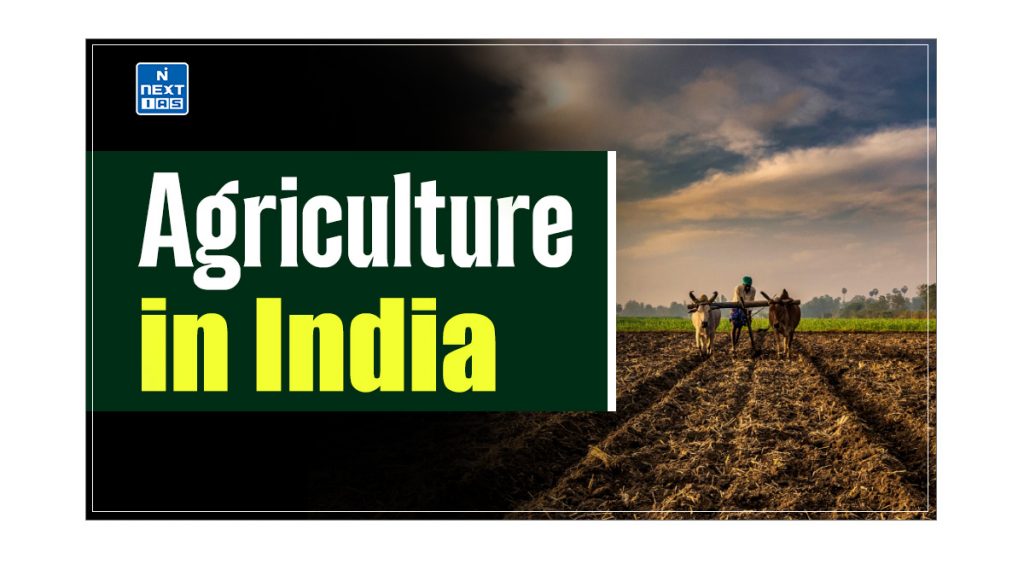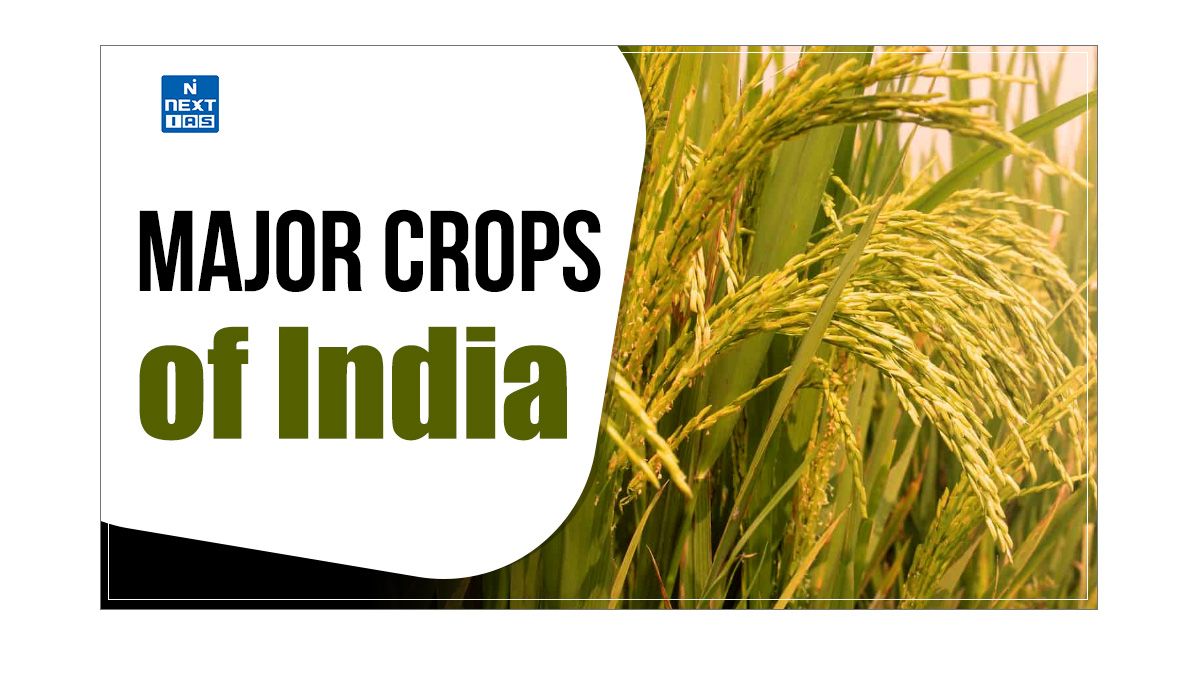
Agriculture in India is a crucial sector that underpins the country’s economy and sustains the livelihoods of millions. The agricultural industry provides food and fibre and plays a significant role in employment, cultural practices, and socio-economic development. This article aims to study in detail the multifaceted aspects of Indian agriculture, exploring its salient features, the determinants of agricultural practices, and the physical and institutional factors influencing this vital sector.
What is Agriculture?
- Agriculture is the practice of cultivating land, growing crops, and raising animals for food, fibre, and other products used to sustain and enhance human life.
- Agriculture is the art and science of cultivating the soil, growing crops, and raising livestock.
- It includes preparing plant and animal products for people to use and distributing them to markets.
- It is a primary activity that serves as the producer for the sustenance of life on earth.
- Agriculture provides most of the world’s food and fabrics. Cotton, wool, and leather are all agricultural products.
- Agriculture also provides wood for construction and paper products.
| Note: About two-thirds of the livelihood of the Indian population is directly or indirectly dependent on agriculture. |
Features of Agriculture in India
Some of the salient features of Agriculture in India are as follows:
- Subsistence Agriculture – Subsistence agriculture in India is a prevalent practice. This agriculture type primarily focuses on producing crops for self-consumption, with no surplus left for sale in the market.
- Commercial Agriculture – Commercial Agriculture is also practised in India, such as tea plantations in Assam, coffee in Karnataka, and coconut farming in Kerala. Commercial agriculture involves the production of crops on a large scale, with the goal of selling the produce in the market to generate profits. However, with limited land resources in India, the growing population is increasing pressure on agricultural activities.
- Mechanisation – After the Green Revolution, there has been an increasing trend in the use of machines in farm operations, leading to agriculture’s mechanisation in India. Punjab, Haryana, Western Uttar Pradesh, the River valleys of Andhra, and Tamil Nadu are major agriculturally mechanised areas in India.
- Monsoon Dependent – Due to a lack of irrigation facilities, 2/3 of agriculture in India depends on monsoon rains.
- Variety of Crops – Due to the presence of different types of topography, diverse soil (like Alluvial, Red, and Black cotton soil, etc.), and other types of climate, India is blessed with the production of different varieties of crops in various regions. For example, Hilly areas are suitable for tea cultivation, and plains are ideal for rice cultivation.
- Predominance of Food Crops – Due to the predominance of subsistence agriculture, food crops are mainly grown to meet the food security demands of the huge Indian population. India has three basic cropping seasonal patterns: Kharif, Rabi, and Zaid.
Determinants of Agriculture in India
The agricultural practices, cropping patterns and productivity are closely determined by the geo-climatic, socioeconomic, and cultural-political factors. The agriculture of any region is influenced by the following factors:
- Infrastructural Factors – Such as Irrigation, Electricity, Roads, Credit and Marketing, Storage facilities, Crop insurance, and Research and Development.
- Institutional Factors – such as land tenure and tenancy, the size of the landholdings, the size of the fields, and land reforms.
- Technological Factors High-yielding varieties (new seeds) were introduced in the Green Revolution, including chemical fertilisers, insecticides, pesticides, and farm machinery.
- Physical Factors Terrain, topography, climate, and soil.
These factors impact cropping patterns, the level of agricultural development, and crop yields in a region individually and collectively.
A brief account of physical factors & Institutional factors has been given below.
Infrastructural Factors
The agriculture in India depends upon the infrastructural factors:
Irrigation
- Irrigation is essential to overcome the spatial and temporal variation of rainfall.
- It is needed because monsoon rainfall is concentrated only for four months. Irrigation will help transform marginal lands like deserts into agricultural areas.
- Also, the Green Revolution’s inputs, such as HYV seeds, chemical fertiliser, pesticides, etc., yield the maximum output only if adequate irrigation facilities are available.
Electricity
- A continuous and good electricity supply is essential to pump the water and irrigate plants.
- Many post-harvest activities also require electricity. States like Punjab, Haryana, Uttar Pradesh, Maharashtra, and Tamil Nadu consume large amounts of their power in the agriculture sector.
- In many states, electricity is provided to farmers at subsidised rates or even free. Various State Government agencies have been calling for abolishing the under-pricing of electricity.
Credit Availability
- A timely and cheap credit supply is essential for conducting farm operations.
- It is necessary in a country like India where 86% of farmers are small and marginal farmers (have less than 20 hectares of landholdings), practice subsistence farming and are very poor.
- The primary reason behind farmers’ suicide in Vidarbha, Andhra Pradesh, Kerala, Karnataka, and other states is heavy indebtedness, as institutional credit is not easily accessible.
- The government, on its part, has been taking many initiatives, such as the Lead Bank Scheme, Rashtriya Krishi Vikas Yojana, Kisan Credit Card, interest subvention on farm loans, debt waiver package for suicide-prone agriculture regions, etc.
Roads, Storage, and Marketing
- These are necessary for connecting agriculture to the market, reducing farm produce wastage, processing farm produce to increase its quality and value, and obtaining better remuneration for farmers.
- The government provides connectivity between agricultural fields and markets by building roads through the Pradhan Mantri Gram Sadak Yojana (PMGSY). Also, the Agriculture Produce Marketing Committee (APMC) runs mandis in every district and block, where marketing and trading facilities for farm produce are provided.
- The Food Corporation of India (FCI) provides price support for farmers and ensures adequate public distribution of food grains. In addition to cooperative groups, private traders buy farm produce, including cash crops, directly from farmers.
- The government also increases storage capacity through the Warehouse Corporation of India (WCI), FCI, and private participation. Agriculture and Processed Food Products Export Development Authority (APEDA) is mandated with promoting and developing the exports of farm produce.
Institutional Factors
The agriculture in India depends upon the institutional factors:
Land Holdings
- Due to the rapid growth of the population and inheritance law, India’s per capita land holding is too small.
- The NSS data shows that of India’s 93.09 million agricultural households, 70.4 per cent hold less than or equal to one hectare, and the average ownership per household is 0.51 hectare.
- The average size of household ownership holdings has declined from 0.725 hectares in 2003 to 0.592 hectares in 2013 and further to 0.512 hectares in 2019.
- The small and marginal holdings (0.00-2.00 hectares) constitute 86.08% of the total holdings.
- The largest land holdings are in Rajasthan(4ha) and Punjab (3.5ha), while in Kerala, it is 0.3 ha and in Uttar Pradesh, 0.72 ha.
- It should be noted that large land holdings are in arid and unirrigated areas, which are not very significant.
- Small and marginal land holdings are economically unviable for the application of modern technology and mechanisation.
Land Reforms
- Land reforms aim to redistribute ownership of land holdings from the social justice perspective and reorganise operational holdings for optimum land utilisation.
- The entire concept of land reform aims to abolish intermediaries and bring actual cultivators into direct contact with the state by giving tenant farmers their rights and work security.
| Note: Among recent initiatives, the government is implementing the National Land Records Modernisation Programme, which seeks to computerise data and copies of rights records. For Example, the Karnataka Government is implementing the Bhoomi Portal. |
Technological Factors
The agriculture in India depends upon the following technological factors:
Seeds
- Traditional varieties of seeds in India are climatically adapted and genetically diverse, but they yield less and are more susceptible to plant diseases. With the green revolution, high-yield varieties of seeds (HYV) were introduced to achieve self-sufficiency in food production.
- However, these seeds have their drawbacks, such as:
- They require more water and fertiliser for optimum production, increasing the capital cost. This created problems for poor farmers, particularly in rainfed areas.
- HYV crops are sensitive to the physical environments in which they grow.
- The loss of diversity due to monocropping leads to new plant diseases.
- Regional disparities in agricultural developments have been seen. They were successful in areas of high irrigation like Punjab, Haryana, Western Uttar Pradesh deltas and areas of peninsular river.
- Intercrop disparities have been observed. Areas under rice and wheat have increased, mainly followed by sugarcane, cotton, and groundnut potatoes. Coarse cereals like jowar, bajra, maize, and oilseed pulses have been neglected.
- Despite these shortcomings, HYV seeds have become the backbone of India’s self-sufficiency in food production.
- GM crops claim resistance to major plant diseases, increasing productivity and various kinds of environmental tolerance.
- Some environmental activists oppose GM crops because the effect of GM crops on human health and the food chain is not yet completely known.
- Monocropping will lead to a loss of plant biodiversity and the emergence of new plant diseases. GM crops are costly and require high amounts of agricultural inputs.
- It will lead to the monopolisation of multinational seed companies and make farmers completely dependent on them.
Fertilisers
- With soil fertility decreasing due to the depletion of nutrients by centuries of farmers, fertiliser use has become essential.
- HYV and GM seeds need more nutrients as they yield more, so increased fertiliser use and irrigation became essential.
- The increasing use of chemical or inorganic fertilisers is responsible for 70% of the overall agricultural growth.
- However, there are following constraints to increase the consumption of fertiliser:
- More than half of the areas of the country being rainfed can absorb only limited amounts of chemical fertilisers.
- The supply of fertiliser is insufficient and unavailable at the right time and in the right forms.
- Small and marginal farmers cannot afford costly fertiliser.
- Inadequate soil testing facilities are needed for the balanced application of nutrients.
- Most fertilisers used in India must be imported in raw material or complete form.
| Note: The burden of continuously rising fertiliser prices falls to a greater extent on the government of India, which subsidises the fertiliser. As a result, the Government has introduced Neem-Coated Urea and Nutrient-Based Subsidy to counter these problems. |
Physical Factors
The agriculture in India depends upon the physical factors:
Terrain, Topography, and Altitude
- Agricultural patterns are heavily influenced by geo-ecological factors such as terrain, topography, slope, and altitude.
- For example, paddy cultivation requires level fields to maintain standing water, whereas tea plantations thrive in rolling terrains where water drains away, as standing water can harm tea plants.
- Coconut orchards are typically found at low altitudes, close to sea level, while apple orchards in tropical and subtropical regions flourish at elevations above 1,500 meters.
- However, crops are rarely grown in areas above 3,500 meters in these latitudes due to thin air, low pressure, low temperatures, and limited oxygen—conditions severely hindering crop cultivation and dairy farming.
- Soils in high mountainous regions are generally underdeveloped, often immature, and prone to erosion due to steep slopes, making them thin and less suitable for agriculture in India.
- Topography also affects agriculture in India by contributing to soil erosion, complicating tillage, and creating challenges for transportation.
- Agricultural mechanisation largely depends on the land’s topography, with rough, hilly terrains being unsuitable for machinery.
- Additionally, topographical features influence rainfall distribution. The windward side of mountains, for example, usually receives more rainfall than the leeward side.
- In the Western Ghats, the windward side receives 250 to 300 cm of rainfall, while the leeward side only receives 75 to 100 cm. Rainfall patterns in a region significantly impact the types of crops that can be cultivated there.
Climate
Among all the physical factors, the climate is one of the most significant determinants of agricultural land use and cropping patterns. The climate of the region, which is important for the growth of plants, includes the following:
- Temperature – All forms of agriculture are largely controlled by temperature. Areas deficient in heat are deficient in agriculture. So, temperature determines vegetation growth by determining the length of the vegetative period.
- Agriculture can occur year-round in lower latitudes, where winters remain mild and do not halt vegetation growth, with farming activities aligned with rainfall patterns.
- In contrast, despite having shorter summers, higher latitudes benefit from extended daylight hours, providing sufficient heat for crops to ripen.
- Temperature and precipitation determine crop types, growth patterns, and combinations.
- Agricultural scientists have identified specific minimum temperatures below which crops cannot grow and optimal temperatures for their most vigorous growth.
- For instance, wheat thrives in Punjab’s cool November-December climate but cannot be cultivated in Kerala during the same period.
- Similarly, apples flourish in Himachal Pradesh, Jammu, and Kashmir, but not in Chennai. Each stage of crop development—germination, leafing, flowering, and fruiting—has specific minimum and optimal temperature requirements.
- Moisture – All crops need moisture. They take water and moisture from the soil, which may be available from the rains or the irrigation system.
- There are optimal moisture conditions for crop development, just as optimal temperature conditions.
- Excess water in the soil alters various chemical and biological processes, limiting oxygen and increasing toxic compounds’ formation in plant roots.
- This leads to stunted plant growth. Drainage practices in an ill-drained tract can solve the soil’s inadequate oxygen problem.
- Heavy rainfall may directly damage plants or interfere with flowering and pollination.
- Rain often lodges cereal crops, making harvest difficult and promoting spoilage and diseases.
- Heavy rainfall at the maturity of wheat, gram, millets, oilseeds, and mustards causes loss of grain and fodder. Indian farmers all over the country have often suffered from rain failure or flood fury.
- Drought – Drought has devastating consequences on crops, yields, and production.
- Soil drought occurs when the water required for transpiration and direct evaporation surpasses the available moisture in the soil.
- This condition causes crop damage due to insufficient soil moisture. India’s drought-prone areas include Rajasthan, Gujarat, Madhya Pradesh, Chhattisgarh, Jharkhand, Maharashtra, Andhra Pradesh, Karnataka, Tamil Nadu, Odisha, Bundelkhand (U.P.), Uttarakhand, J&K, southwest Punjab, and Haryana.
- In regions where annual rainfall averages below 75 cm, agriculture heavily depends on the monsoon, making it highly unpredictable.
- The Vidarbha region in Maharashtra has seen a high rate of farmer suicides due to crop failures caused by drought, primarily stemming from inadequate irrigation facilities.
- The frequency and severity of drought can be assessed through the distribution of annual, seasonal, and daily rainfall.
- Additionally, different plants have varying moisture needs. In India’s drought-prone regions, dryland farming is commonly practiced, whereas in areas with higher rainfall, intensive paddy cultivation is more prevalent.
- Snow – Snow reduces the ground temperature, hindering crop germination and growth.
- Because of permafrost, land under snow cannot be prepared for sowing.
- Snow melting may cause hazardous floods in the summer season, adversely affecting crops, livestock, and land property.
- Winds – Winds have both direct and indirect effects on crops.
- Strong winds can damage plant structures, causing cereals, fodder, cash crops, and shelter seed heads to be dislodged.
- Fruit and nut crops may be blown off trees during high winds, while smaller plants can be completely buried by windblown dust or sand.
- Winds also have an indirect impact by carrying moisture and heat through the air.
- This wind movement accelerates evaporation and transpiration, potentially depriving plants of the moisture they need.
Soils
- The soil is probably the most critical determining physical factor in agricultural operations.
- It determines cropping patterns, associations, and production. Soil fertility, texture, structure, and humus content directly affect crops and their productivity.
- In general, the alluvial soils which are found in the river valleys are considered to be good for wheat, barley, gram, oilseeds, pulses, and sugarcane. In contrast, the clayey loam soil with fine grains found in the Ganga-Brahmaputra deltaic regions gives a good harvest of Rice and Jute.
- Black soil is known for cotton in Maharashtra, and sandy soil is known for guar and pulses (green gram, black gram, red gram, etc.) in Rajasthan.
- Saline and alkaline soils, such as those in Punjab and Haryana, are useless from an agricultural point of view unless they are reclaimed by chemical fertilisers and biological manures and fertilisers.
Importance of Agriculture in Indian Economy
- Agriculture plays a crucial role in the Indian economy. It serves as the backbone of the nation and provides livelihoods to nearly half of its population.
- It contributes significantly to the GDP and is vital for ensuring food security, sustaining rural communities, and supporting the agro-based industries that depend on agricultural produce.
- Agriculture also plays a key role in export earnings, with commodities like rice, spices, and cotton being major contributors.
- Additionally, it is central to India’s socio-economic development, driving employment, reducing poverty, and fostering economic stability, particularly in rural areas.
- Despite the increasing importance of other sectors, agriculture remains indispensable for India’s economic growth and overall development.
Conclusion
Indian agriculture is a complex and dynamic sector shaped by various physical, socio-economic, and technological factors. Despite the challenges posed by climate variability, small landholdings, and limited resources, the sector remains a cornerstone of the Indian economy. Continued efforts to improve infrastructure, adopt modern technologies, and implement effective land reforms are essential to enhance productivity and sustainability in agriculture.
Frequently Asked Questions (FAQs)
What is the influence of the Himalayas on Indian agriculture?
The Himalayas significantly influence Indian agriculture by acting as a natural barrier that protects the country from cold winds from Central Asia, enabling a more moderate climate suitable for agriculture.
What is the importance of agriculture in Indian economy?
Agriculture is a cornerstone of the Indian economy, providing livelihoods for nearly half of the country’s population and serving as a critical source of employment. It contributes significantly to the GDP, supports rural development, and ensures food security for the nation.
What is agriculture in India?
Agriculture in India is a diverse and crucial sector that is central to the country’s economy and sustenance. It involves the cultivation of a wide variety of crops, including staples like rice, wheat, and pulses, as well as cash crops such as cotton, tea, coffee, and sugarcane.
Who is the father of Indian agriculture?
M. S. Swaminathan is the father of Indian agriculture.






